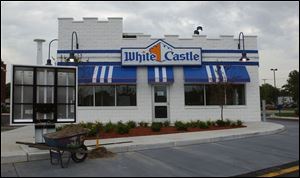
60 jobs at Toledo restaurant draw 560 hopefuls
8/12/2003
The number of applicants at the new White Castle reflects rising unemployment in Toledo and other Ohio cities.
Metro Toledo's first White Castle restaurant won't open until Sunday, but people have already started to line up outside the central city fast food outlet. They were looking for jobs.
Over a four-day period, 560 people applied for 60 jobs, according to officials of the Columbus chain. “Five hundred is unbelievable,” said spokesman Kelly Collins.
The situation reflects rising unemployment in the city of Toledo and most other urban centers in Ohio, which have been hit especially hard by the national economic slump.
Joblessness in the confines of Toledo rose to 9.8 percent in June from 8.7 percent in May and 8.5 percent in June, 2002. Nearly 16,000 Toledo workers were unemployed.
And Toledo wasn't alone. Ohio cities that had jobless rates at or above 10 percent in June included Cleveland (13.3 percent), Youngstown (13.7 percent), Dayton (12 percent), and Lorain (10.9 percent).
Economists cautioned that unemployment problems tend to be exaggerated in June by the entrance of students into the workforce and seasonal shutdowns and reduced production at auto plants that are a big part of the economies of Toledo and a number of other places.
But, they added, there is no denying that many urban areas, with larger concentrations of less skilled workers and minorities who tend to have higher unemployment rates, were hurt by the sluggish economy of recent years.
“ ... The unemployment rate is high right now and that is the toll of this recession,” said Eileen Granata, a vice president for research at Toledo's Regional Growth Partnership.
“We recognized when this recession first started, the longer it went on, the more painful it was going to be, particularly in places with large industrial bases like we have.”
Even in good times, unemployment is higher in most cities than in suburban areas, she noted.
People applying for jobs at fast-food restaurants tend to be younger and possess fewer skills, added Mark Schweitzer, an economist with the Federal Reserve Bank in Cleveland. “These are groups in which the unemployment rate is typically much higher than average,” he added.
“When you're in a period with little to no job growth, as we are now, the problem is exacerbated.”
The White Castle, at Cherry and Bancroft streets, stopped taking applications after four days and has hired most of its work force, said Diana Ford, a district supervisor.
Applicants reflected a broad age spectrum, she added.
The chain's spokesman, Mr. Collins, said newly built restaurants typically receive 150 applications.
The chain is paying $8 an hour in Toledo, but many applicant said they were attracted by the health benefits that go with many of the jobs.
Employment experts said that demand for jobs is high throughout Lucas County, which recorded a jobless rate of 8.4 percent in June.
Max & Erma's, which opened a restaurant in Sylvania Township Aug. 4, received more than 1,000 applications for 125 jobs there. “It's a sign of the times,” said General Manager Sue Northway. Three out of four applicants were students in high school or college. “A lot of them were working temporary jobs and looking for permanent work,” she said.
Toledo isn't unusual, she said. “Help wanted” advertisements drew 1,500 applicants at a Max & Erma's opened in February in Auburn Hills, Mich., north of Detroit. Just a few years ago, however, advertising typically attracted about 225 applicants, she said.